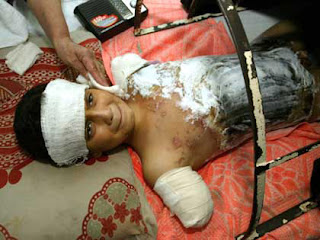 http://www.thisisjersey.com/hmd/imageviewer.pl?1000232
http://www.thisisjersey.com/hmd/imageviewer.pl?1000232
Monday, March 3, 2008
Murder of defenseless Poles by Nazi Germany

Kazimiera Mika, a 10-year-old Polish girl, stoops over the body of her older sister. The elder Mika girl and six other women, desperate for food, had been digging for potatoes in a field in besieged Warsaw when the Luftwaffe struck. Nazi fliers swooped down to within 200 feet of the ground and attacked the group with machine-gun fire. Two were killed. As the aircraft left, Kazimiera ran to her fallen sibling. This was Kazimiera's first experience with the finality of death, and she was unable to understand why her sister could no longer speak to her.
Ciwil War in Nepal
Sunday, March 2, 2008
Lebanon War

“The child whose dead body lies like a rag doll beside the cars which were supposedly taking her and her family to safety is a symbol of the latest Lebanon war” (Robert Fisk). Name unknown, her parents were also killed in Israeli attack on refugee column outside Ter Harfa, Lebanon, July 15.
http://www.internationalist.org/israellebanonwar0607.html
Burundi - DRC Refugees - Gatumba Refugee Camp Survivors

A Gatumba massacre victim shows her scars. On August 13, 2004 a force of armed combatants, many of them members of the Forces for National Liberation (FNL), massacred at least 152 Congolese civilians and wounded another 106 at Gatumba refugee camp. The FNL is a predominantly Hutu rebel movement known for its hostility to Tutsi and the victims were largely Banyamulenge, an ethnic group often categorized with Tutsi. But the massacre was more than just another case of ethnically-targeted slaughter in a region known for such horrors. At the intersection of two faltering peace processes, the attack underlined the continuing political conflicts within both the Democratic Republic of the Congo and Burundi and made them worse. The Gatumba camp provided shelter for 1,700 refugees who had fled DR Congo in June 2004.
http://www.christophecalais.com/
Famine in Somalia
NATO Troops Entering Kosovo During the War
Subscribe to:
Comments (Atom)





